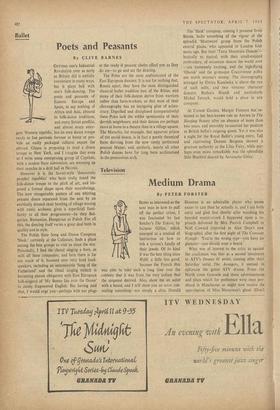Ballet
Poets and Peasants
By CLIVE BARNES
However it is the Soviet-style `democratic peoples' republics' who have really tuned the folk-dance troupe to the pitch of art, and im- posed a formal shape upon their meanderings. The now recognisable pattern of one whirling peasant dance separated from the next by an exotically dressed choir bawling of village wooing with rustic archness gives a superficial fami- liarity to all their programmes—be they Bul- garian, Rumanian, Hungarian or Polish. For all this, the dancing itself varies a great deal both in quality and in style.
The Polish State Song and Dance Company 'Slask,' currently at the Coliseum, finds a place among the best groups to visit us since the war. Personally, I find the choral singing a bore, as with all these companies, and here there is far too much of it, boomed over very loud loud- speakers, including an interminable 'Song of the Fatherland' and the ritual singing (which is becoming almost obligatory with East European folk-singers) of 'My Bonny lies over the Ocean' in cutely fragmented English. But having said that, I would urge you—perhaps with ear plugs at the ready if peasant choirs affect' you as they do me—to go and see the dancing.
The Poles are the most sophisticated of the East European dancers. It is not for nothing that, Russia apart, they have the most distinguished classical ballet tradition east of the Rhine, and many of their folk-dances derive from warriors rather than farm-workers, so that most of their choreography has an intriguing glint of aristo- cracy. Dignified and disciplined (comparatively) these Poles lack the wilder spontaneity of their dervish neighbours, and their dances are perhaps more at home in a theatre than in a village square. The Mazurka, for example, that apparent prince of the social dance, is in fact a purely theatrical form deriving from the now rarely performed peasant Mazur; and, similarly, nearly all other Polish dances have for long been acclimatised to the proscenium arch. The `Slask' company, coming I presume from Silesia, lacks something of the vigour of the splendid `Mazowsze' group from the Polish central plains, who appeared in London foUr years ago. But their 'Tatra Mountain Dances'— basically so typical, with their small-stepped embroidery, of mountain dances the world over —are immensely exciting, and the high-flying `Oberek' and the grotesque Cracovienne polka are worth anyone's money. The choreography arranged by Elwira Kaminska is above the run of such mills, and two virtuoso character dancerS, Barbara Brandt and particularly Michal Jarczyk, would hold a place in any company.
At Covent Garden, Margot Fonteyn has. re- turned to her best-known role as Aurora in The Sleeping Remit), after an absence of more than two years, and smoothly re-asserted her position as British ballet's reigning queen. Yet it was also a night for the Royal Ballet's young entry. Tall and captivating Deanne Bergsma showed a gracious authority as the Lilac Fairy, while per- haps even more remarkable was the splendidly lithe Bluebird danced by Antoinette Sibley.






































 Previous page
Previous page